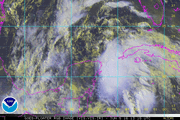| Tropical storm (SSHWS/NWS) | |
 Arlene making landfall in the Big Bend of Florida on June 9 | |
| Formed | June 7, 2017 |
|---|---|
| Dissipated | June 12, 2017 |
| (Extratropical after June 10) | |
| Highest winds | 1-minute sustained: 70 mph (110 km/h) |
| Lowest pressure | 987 mbar (hPa); 29.15 inHg |
| Fatalities | 3 direct |
| Damage | $10 million (USD) |
| Areas affected | Yucatan Peninsula, Southeastern United States |
| Part of the 2017 Atlantic hurricane season | |
Tropical Storm Arlene was a strong but disorganized tropical storm that brought heavy rains to the southeastern United States in June 2017. It was the first named storm of the moderately active 2017 Atlantic hurricane season.
Meteorological History[]

The track of Arlene.

Tropical Storm Arlene shortly after being named
On June 4, The National Hurricane Center began monitoring an area of disturbed weather in the western Caribbean Sea with some isolated convection. This area merged with the remnants of Tropical Depression Two-E from the East Pacific. Late on June 6 at 03:00 UTC, after development chances entered the high category, the NHC initiated advisories on "Potential Tropical Cyclone One," the first Atlantic system to have advisories on it before it even became a tropical cyclone. The next day, on June 7, after a Hurricane Hunter reconnaissance aircraft successfully identified a closed circulation center, the low was classified as Tropical Depression One. 6 hours later, a strong burst of convection took place and the depression was upgraded to Tropical Storm Arlene, becoming the latest first named storm of the Atlantic hurricane season since Arthur in 2014. Although the NHC only expected slight intensification due to the cyclone's disorganized structure typical of June Atlantic tropical cyclones, on June 8 a Reconnaissance Aircraft found that the central pressure had fallen to 987 mbar, in addition to surface winds of up to 70 mph. Despite being forecast to reach hurricane strength at one point, the strong tropical storm retained this intensity for the next day as it made landfall in northwestern Florida. Arlene failed to weaken much over land, maintaining winds of up to 60 mph before it turned extratropical over Virginia on June 10. Arlene brought heavy rains to the southeastern United States, although the rain was not nearly as significant as rain brought by Hurricane Matthew the previous year.
